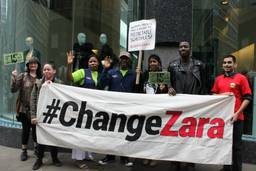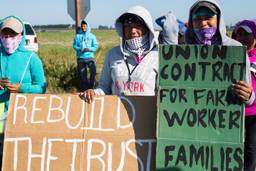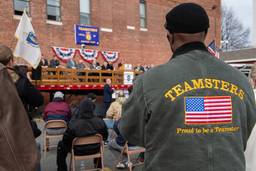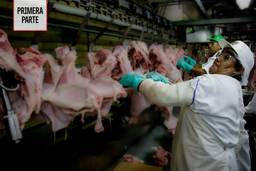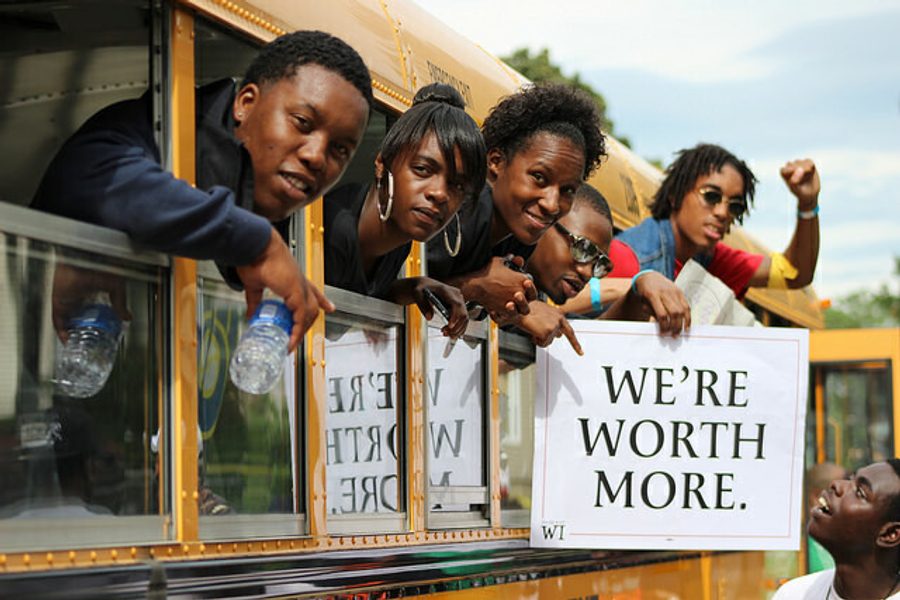
As thousands of low-wage workers are rallying and striking Wednesday, demanding $15 an hour and a union, their high-profile mobilization has already inspired workers in a range of industries far beyond fast food.
From school support staff to UPS part-timers, Fight for 15 is raising the confidence of unions to put bold demands on the bargaining table for their own low-wage members — and to back up those demands with community action.
The surge in low-wage worker organizing is also fueling campaigns to boost the minimum wage, spreading the momentum for $15 to new cities, including a wave of action across Canada.
Raising confidence
Temporary workers at the Metro regional government in Portland, Oregon, won major wage increases in their first contract after AFSCME Local 3580 partnered with 15 Now Portland and Jobs with Justice.
Under the new contract, hazardous waste workers will see their wages rise from $13.55 to $17.50, and zoo security workers from $12 to $15.75.
While these jobs are considered temporary and seasonal, some workers have been doing them for 20 years. The union argued that this “perma-temp” system lowered wages for all workers, and pushed for temporary workers to be paid 80 percent of full-time colleagues’ wage.
April 15 actions
Fast food and retail workers will be joined on April 15 by childcare workers, adjunct professors, home care workers, airport workers, and students in one-day strikes in 200 cities, as part of the Service Employees-backed Fight for 15 movement.
Many actions will target McDonald’s. Workers dismissed the company’s recent announcement of a $1 pay raise as a publicity stunt, pointing out that nearly all McDonald’s workers will still be paid less than $10 an hour. The raise does not apply to the 90 percent of workers employed at franchises.
Ross Grami, AFSCME Council 75 representative, says the community pressure from allies was a critical factor in their win, with 15 Now and Jobs for Justice joining AFSCME at the bargaining table on the last day.
“I don’t think I could have sat at the table five years ago and demanded an employer pay a living wage of $15. Most employers would have laughed at us and laughed at our bargaining unit,” said Grami. “The organizing workers are doing nationally and the sacrificing they have had to do has changed the conversation and changed perceptions around the table.”
Tim Combs, a temporary hazardous waste worker who joined the bargaining team, describes the 30 percent raise as a game-changer and says other groups of temps are now approaching AFSCME to organize, too.
Leaders of the Chicago Teachers Union announced in late March that, as part of upcoming contract talks, they will seek a minimum of $15 for all school employees and subcontractors, both CTU members and others.
The spillover effect of Fight for 15 organizing is not confined to public sector workers. Teamsters Local 804, which represents UPS workers in New York City, is joining the mobilization for a $15 city minimum wage.
The national UPS contract sets the starting rate for part-timers at $10, and many make less than $15.
“I made close to $10 when I started 30 years ago, and the minimum wage [then] was around $2.75, so as part-timers we were doing good,” said Local 804 steward Greg Welch. “Somehow the company managed all these years to hold the part-timers at this wage — it’s like time stood still. To me, to see that only as of last year, part-timers were starting at $10, it’s crazy.”
Local 804 members will hold actions at UPS hubs throughout New York City on April 15 before joining a citywide demonstration later in the day.
Meanwhile, nursing home workers in Connecticut voted to strike for better wages and sent strike notices to 27 nursing homes last week. The workers, members of Service Employees (SEIU) 1199 NE, adopted a $15 minimum wage demand in statewide negotiations in January. Over half make less than $15. (The strike was postponed at the governor’s request.)
Momentum spreads in Canada
The Fight for 15 is also spreading north of the border. Although minimum wages in Canada are higher than in the U.S. — ranging from $10.20 in Alberta to $11 in Ontario — they still remain below the official poverty line.
In Ontario, the minimum was frozen at $10.25 for four years. Inspired by the momentum generated by the Fight for 15 in the U.S., in March 2013 unions and community groups launched a campaign that bumped the provincial minimum to $11 in 2014, with annual cost-of-living increases. On April 15 the campaign will launch a new Ontario-wide campaign for $15 and Fairness, adding demands for paid sick days and adequate and regular hours.
“We need to keep fighting because $11 is not enough,” said Serena White, a retail employee and leader at the Workers’ Action Centre in Toronto. “You can’t afford to pay your rent, you can’t afford to pay your bills, you can’t afford to go out, you can’t afford to do anything, really.”
Workers and allies will be rallying tomorrow outside McDonald’s headquarters and at the Ontario Ministry of Labour in Toronto. Pickets are planned in 12 other communities, including at McDonald’s in Hamilton, Thunder Bay, London, and Peterborough.
Workers at the Toronto airport will be launching a campaign on the same day for a $15 minimum wage and better job security and working conditions. Although a little over half the 40,000 airport workers are unionized, contract flipping between service providers results in low wages and precarious work for both union and non-union workers.
“You have workers doing a job for 12 to 15 years still at minimum wage — every time they get a raise, someone else comes in and undercuts the bid and the workers start over at minimum wage,” explains Sean Smith, mobilizing coordinator at Unifor Local 2002, and a representative of the Toronto Airport Workers Council that is bringing together union and non-union workers.
“There has to be some sort of acknowledgment of the people who run the airport for you — that are there are every day, making sure it’s clean, making sure the passengers are taken care of,” said Phillipe Buckland, an Air Canada customer service agent and Unifor local officer. “People can’t afford to live like this.”
Last year the airport workers council went to Seattle to meet with hospitality and transportation workers who had won a $15 minimum wage at the Seattle-Tacoma airport in 2013. The $15 minimum was struck down after a legal challenge by employers, but an appeal is pending before the Washington Supreme Court. Smith describes the cross-pollination with U.S. movements: “Fight for 15 in a lot of jurisdictions started in the airports. It’s important to tie our movement with other movements happening across the continent.”
Nova Scotia and British Columbia are also seeing campaigns for a provincial $15 minimum. In B.C., the Federation of Labour is leading the fight, and is planning actions outside low-wage employers tomorrow, including leafleting outside a McDonald’s training center.
The B.C. government recently announced that in September it will increase the minimum wage 20 cents, to $10.45. Jim Chorostecki, executive director of the BCFED, says if anything this meager increase has given the campaign new momentum.
The national mobilization around low wages has also pushed the New Democratic Party, the official federal opposition party, to announce a $15 federal minimum wage as a major plank of its election platform.
Pam Frache, an organizer with the Workers’ Action Centre, describes the significance of the NDP announcement: “I don’t think it would have happened if it were not for the success of the Ontario campaign and developments in the U.S. that really built people’s confidence,” she said. “It makes it a pan-Canadian conversation in an unprecedented way and builds the strength of movements on the ground fighting for 15.”
Raising the floor
The momentum generated since the first fast food strikes in November 2012 is making unions rethink strategies for raising pay for low-wage workers, both union and non-union.
“There are still unionized workers who make less than $15,” said Chorostecki. “The more we have a minimum wage campaign, the more it assists them to bargain effectively to get good wages.”
But organizers also feel that winning fair wages at the bargaining table strengthens legislative and city ordinance campaigns.
“If the airport workers get a win in their collective bargaining demands, it can seed back into the broader campaign to raise the floor for all workers,” says Frache. “This will make it easier to win future bargaining demands.”
That’s exactly what Combs hopes will happen with the temporary workers’ victory in Portland. He will be speaking at a Portland Fight for 15 rally tomorrow and wants to encourage other workers to raise their expectations: “I’m going to let people know: Look, you can get this, you don’t have to be part of a union necessarily. The movement is bigger than the union.”

I hope you found this article important. Before you leave, I want to ask you to consider supporting our work with a donation. In These Times needs readers like you to help sustain our mission. We don’t depend on—or want—corporate advertising or deep-pocketed billionaires to fund our journalism. We’re supported by you, the reader, so we can focus on covering the issues that matter most to the progressive movement without fear or compromise.
Our work isn’t hidden behind a paywall because of people like you who support our journalism. We want to keep it that way. If you value the work we do and the movements we cover, please consider donating to In These Times.

